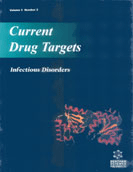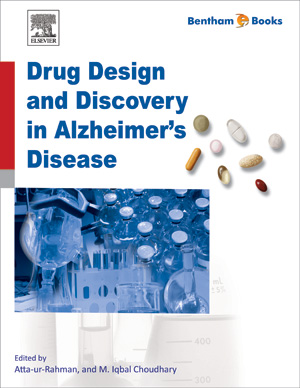Book Volume 4
Preface
Page: i-i (1)
Author: Atta-ur-Rahman and M. Iqbal Choudhary
DOI: 10.2174/9781681083971119040001
List of Contributors
Page: ii-iii (2)
Author: Atta-ur-Rahman and M. Iqbal Choudhary
DOI: 10.2174/9781681083971119040002
Retinal Angiogenesis: Towards a Cure
Page: 1-18 (18)
Author: Rachel M. Knott
DOI: 10.2174/9781681083971119040003
PDF Price: $30
Abstract
Retinal angiogenesis is evident in a number of different pathological and degenerative conditions including proliferative diabetic retinopathy, retinopathy of prematurity and age-related macular degeneration. There have been numerous attempts to control retinal angiogenesis but the fragility of the tissue and the presence of the blood retinal barrier limiting the transport of pharmacological agents has proved problematic in the therapeutic regulation of this process. This chapter presents the structure of the retina in relation to the structure of the eye. In addition, the molecular initiators of angiogenesis are discussed and in particular how the hyperglycaemic environment leads to oxidative stress in proliferative diabetic retinopathy. The lack of perfusion due to damage from the diabetic milieu, the impaired retinal development in the case of retinopathy of prematurity and the aging of the retinal pigment epithelial cells are characteristics that are associated with angiogenesis. The consequent reduction in oxygen level that follows impaired perfusion creates an hypoxic environment that stabilises hypoxia inducible factor type 1 alpha and precipitates the activation of hypoxia inducible factor type 1. The activation of this transcription factor leads to the increased expression of a number of genes including vascular endothelial growth factor and this is central to the angiogenic process. The development of specific pharmacological inhibitors of aldose reductase, protein kinase Cβ, advanced glycatedend products, hypoxia inducible factor type 1 alpha and vascular endothelial growth factor are reviewed. Inhibition using small interfering RNAs to inhibit specific pathways and the use of cell replacement is discussed in terms of their therapeutic potential.
Cancerous Tumor Growth, Driven by Hypoxia Induced Angiogenesis is Slowed by Brief Daily EMF Therapy
Page: 19-33 (15)
Author: Ivan Cameron
DOI: 10.2174/9781681083971119040004
PDF Price: $30
Abstract
As cancerous tumors grow their continued increase in cancer cell number becomes dependent on an increased blood supply from the surrounding host non-tumor tissue. Tumor cancer cells furthest from the host blood supply become hypoxic and without an increased blood supply these cancer cells become necrotic and die. The cancer cells that become hypoxic are triggered to synthesize hypoxia inducible factor (HIF) and vascular endothelial growth factor (VEGF) that is released from the hypoxic cell to stimulate a major increase in sprouting of endothelial cells. Thus neoangiogenesis in the tumor is apparently hypoxia driven in tumors.
Our research group found that a brief daily therapeutic electromagnetic field exposure (TEMF) slowed breast cancer tumor growth in syngenetic mice. The optimal TEMF exposure dose for retardation of tumors growth and angiogenesis without harmful side effects was a 120 Hz semi-sine wave given at 15 mT for 10 minutes a day. This TEMF therapy gave the maximum antiangiogenic effect with no noticeable side effects. Although this TEMF slowed tumor growth it did not cause the tumors to shrink in size.
An experiment was done to find out if combining two different therapies, one targeting angiogenesis (TEMF) and the other targeting killing of rapidly dividing cells (gamma irradiation-IR), might have an additive tumor inhibitive effect. In short TEMF, combined with IR proved to have a significant additive tumor inhibiting effect and TEMF was judged to be a safe effective adjunct to IR therapy.
Angiogenesis in Cancer Treatment: 60 Years’ Swing Between Promising Trials and Disappointing Tribulations
Page: 34-96 (63)
Author: Khalid Alhazzani, Ali Alaseem, Mohammad Algahtani, Sivanesan Dhandayuthapani, Thiagarajan Venkatesan, Appu and Rathinavelu
DOI: 10.2174/9781681083971119040005
PDF Price: $30
Abstract
Pathological angiogenesis plays essential role in tumor progression, invasiveness, and metastasis. This process is highly stimulated by VEGF/VEGFR signaling pathway(s). Additional players such as Ang/Tie-2, FGF/FGFR, and Notch signals are also involved in this complex process by stabilization and maturation of blood vessels. As a result of the identification of molecular pathways and various targets driving angiogenesis, several agents have been developed for cancer treatment. Among various pathways, targeting VEGF/VEGFR2 has been proven to be the most effective to inhibit tumor angiogenesis and subsequent tumor growth in preclinical and clinical settings. This chapter highlights on the ramification of some of the crucial events that leads to the maturation of angiogenesis, explore the perplex process of angiogenesis and discuss the amenable strategies for intervention. We will discuss about the myriad number of current therapeutic agents based the target selectivity, preclinical findings, clinical application, and toxicity profile.
Anti-Angiogenesis Drugs: Hopes and Disappointments in Certain Cancers
Page: 97-107 (11)
Author: Georgios M. Iatrakis
DOI: 10.2174/9781681083971119040006
PDF Price: $30
Abstract
In cancer, neovascularization seems necessary for tumor progression and metastasis. The hypothesis that cancer progression is angiogenesis-dependent has repeatedly been confirmed by experimental inhibition of tumor growth with angiogenesis inhibitors. Receptors for VEGF (VEGFRs) are expressed on tumor endothelium and tumor cells and, as expected, VEGF-A overexpression is associated with poor prognosis (reduced survival). There are both positive and negative angiogenesis regulators and, as such, two strategies for inhibiting pathologic angiogenesis can be adopted: the inhibition of positively-acting agents (e.g., VEGFR inhibitors) and the administration of negatively-acting agents (e.g., angiostatin (from the Greek words "angio" and "stasis" meaning stopping)).
Anti-Angiogenic Therapy for Retinal Diseases
Page: 108-136 (29)
Author: Mitzy E. Torres Soriano, Jesica Dimattia and Maximiliano Gordon
DOI: 10.2174/9781681083971119040007
Abstract
Ocular angiogenesis is a major cause of disease and permanent blindness. The introduction of anti-vascular endothelial growth factor (anti-VEGF) agents has revolutionized the treatment of retinal vasogenic conditions. These drugs are now commonly employed for the treatment of a group of ocular pathologies, including exudative macular degeneration, diabetic macular edema, and retinal vein occlusion.
The most common anti-VEGF therapies for retinal diseases are bevacizumab (Avastin®), ranibizumab (Lucentis®) and aflibercept (Eylea®).
Multicenter, randomized, controlled clinical trials have been designed to study the efficacy of anti-VEGF therapy in common retinal angiogenic diseases. However, when it comes to extremely rare or uncommon retinal diseases, we must often rely on case studies or small series to elucidate a potential beneficial effect of anti-VEGF treatment. Continued experience with the use of anti-VEGF pharmacotherapy may offer additional treatment modalities for these conditions that have limited therapeutic options, and may also provide insight into their molecular pathophysiology.
In this chapter, we will describe the role of angiogenesis in retinal diseases, antiangiogenic therapies that are available at the moment, evidence based on clinical trials and new researches on ocular anti-VEGF therapy.
Molecular Targets of Angiogenesis and Future Potential of Anti-angiogensis Therapy in Multiple Sclerosis
Page: 137-161 (25)
Author: Manisha J. Oza, Sachin V. Suryavanshi, Mayuresh S. Garud, Sandip T. Auti, Ankit P. Laddha and Yogesh A. Kulkarni
DOI: 10.2174/9781681083971119040008
PDF Price: $30
Abstract
Multiple sclerosis (MS) is a chronic, inflammatory, gray and white matter demyelinating disease of the central nervous system characterized by axon degeneration, oligodendrocytes damage and astrogliosis. As per epidemiological data obtained from national multiple sclerosis society, 2.3 million people are suffering from MS worldwide. In America and Europe, it is a leading cause of mortality in young adults. The MS international federation reports showed that the prevalence of MS has been increased up to 33/10000 in 2013 from 30/10000 in 2008. Along with degerative processes, such as axon damage and myelin sheaths destruction, inflammatory components, such as lymphocytes and macrophages also play pivotal role in the pathogenesis of MS. There is an infiltration of immune cells, macrophages and microglia, increased expression of cytokines and chemokines. The structural and functional changes in Blood Brain Barrier occur very commonly in MS.
Angiogenesis is a process of development of new blood vessels from the existing blood vessels. It is commonly involved in various CNS disorders, such as stroke, epilepsy and tumors, indicating that it might have a role in the progression of MS lesions. The inflammatory components involved in pathogenesis of MS have been observed to play significant role to support angiogenesis. Inter cellular cell adhesion molecule-1 (ICAM-1), vascular endothelial growth factor (VEGF), vascular cell adhesion molecule (VCAM) -1, matrix metalloproteinase -1, -2, -3, -7 and 9 (MMP-1,-2,-3,-7,-9), TNF-α /-β, Interferon – γ (IFN– γ) and many other components are involved in angiogenesis processes of MS. Moreover, MMPs and VEGF play significant role in vascular basement membrane degradation and breakdown of BBB in MS. This indicates that there is a firm link between angiogenesis and chronic inflammation for neovascularization in the progression of MS. Since the inflammation and angiogenic processes are very complex and involve multiple biochemical processes, there are several molecular targets associated with angiogenesis for therapeutic intervention in MS.
Thus, the aim of the present chapter will be to show the link between angiogenesis and inflammatory processes in the progression of multiple sclerosis. Furthermore, the chapter is also focused on the role of molecular targets of angiogenesis process in MS along with their inhibitors or activators from various sources.
Angiogenesis and Portal Hypertension: An Update
Page: 162-218 (57)
Author: Dmitry Victorovich Garbuzenko, Nikolay Olegovich Arefyev and Evgeniy Leonidovich Kazachkov
DOI: 10.2174/9781681083971119040009
PDF Price: $30
Abstract
Developing medicines for hemodynamic disorders that are characteristic of cirrhosis of the liver is a relevant problem in modern hepatology. The increase in hepatic vascular resistance to portal blood flow and subsequent hyperdynamic circulation underlie portal hypertension (PH) and promote its progression, despite the formation of portosystemic collaterals. Angiogenesis and vascular bed restructurization play an important role in PH pathogenesis as well. In this regard, strategic directions in the therapy for PH in cirrhosis include selectively decreasing hepatic vascular resistance while preserving or increasing portal blood flow, and correcting hyperdynamic circulation and pathological angiogenesis. The aim of this review is to describe the mechanisms of angiogenesis in PH, methods for studying angiogenesis in experimental research, and the perspectives of antiangiogenic therapy. Although most angiogenesis inhibitors were studied only in animal experiments, this selective therapy for abnormally growing newly formed vessels is pathogenetically reasonable to treat PH and associated complications.
Subject Index
Page: 219-228 (10)
Author: Atta-ur-Rahman and M. Iqbal Choudhary
DOI: 10.2174/9781681083971119040010
Introduction
The inhibition of angiogenesis is an effective mechanism of slowing down tumor growth and malignancies. The process of induction or pro-angiogenesis is highly desirable for the treatment of cardiovascular diseases, wound healing disorders, etc. Efforts to understand the molecular basis, both for inhibition and induction, have yielded fascinating results. Anti-angiogenesis Drug Discovery and Development provides an excellent compilation of well-written reviews on various aspects of the anti-angiogenesis process. These reviews have been contributed by leading practitioners in drug discovery science and highlight the major developments in this exciting field in the last two decades. The feast of these reader-friendly reviews on topics of great scientific importance – many of which are considered significant medical breakthroughs, makes this series excellent reading both for the novice as well as for expert medicinal chemists and clinicians. This volume brings together 5 reviews on the following topics: - Retinal angiogenesis - Effects of brief daily EMF therapy on tumor growths - Evolution of the role of angiogenesis in cancer treatments over six decades - Anti-angiogenesis drugs - Anti-angiogenesis therapy for multiple sclerosis - Update on the link between angiogenesis and portal hypertension






















